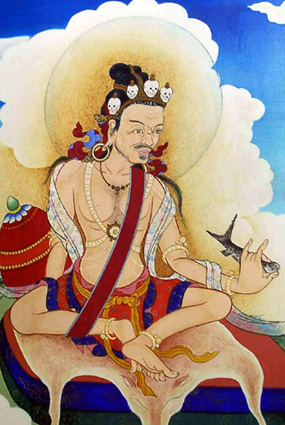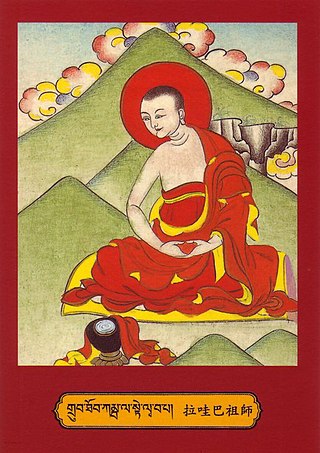
Longchen Rabjam Drimé Özer, commonly abbreviated to Longchenpa was a Tibetan scholar-yogi of the Nyingma school of Tibetan Buddhism. According to tibetologist David Germano, Longchenpa's work led to the dominance of the Longchen Nyingthig lineage of Dzogchen over the other Dzogchen traditions. He is also responsible for the scholastic systematization of Dzogchen thought within the context of the wider Tibetan Vajrayana tradition of philosophy which was highly developed at the time among the Sarma schools. Germano also notes that Longchenpa's work is "generally taken to be the definitive expression of the Great Perfection with its precise terminological distinctions, systematic scope, and integration with the normative Buddhist scholasticism that became dominant in Tibet during the thirteenth and fourteenth centuries."

Padmasambhava, also known as Guru Rinpoche and the Lotus from Oḍḍiyāna, was a tantric Buddhist Vajra master from medieval India who taught Vajrayana in Tibet. According to some early Tibetan sources like the Testament of Ba, he came to Tibet in the 8th century and helped construct Samye Monastery, the first Buddhist monastery in Tibet. However, little is known about the actual historical figure other than his ties to Vajrayana and Indian Buddhism.

Mahasiddha is a term for someone who embodies and cultivates the "siddhi of perfection". A siddha is an individual who, through the practice of sādhanā, attains the realization of siddhis, psychic and spiritual abilities and powers.

Tilopa was an Indian Buddhist tantric mahasiddha who lived along the Ganges River. He practised Anuttarayoga Tantra, a set of spiritual practices intended to accelerate the process of attaining Buddhahood. He became a holder of all the tantric lineages, possibly the only person in his day to do so. In addition to the way of insight and Mahamudra, Tilopa learned and passed on the Way of Methods and guru yoga. Naropa is considered his main student.

Nāropā or Abhayakirti was an Indian Buddhist Mahasiddha. He was the disciple of Tilopa and brother, or some sources say partner and pupil, of Niguma. As an Indian Mahasiddha, Naropa's instructions inform Vajrayana, particularly his six yogas of Naropa relevant to the completion stage of anuttarayogatantra. He was also one of the "gatekeepers" of Vikramashila monastery which is located in Bihar.

Jamgön Kongtrül Lodrö Thayé, also known as Jamgön Kongtrül the Great, was a Tibetan Buddhist scholar, poet, artist, physician, tertön and polymath. He is credited as one of the founders of the Rimé movement (non-sectarian), compiling what is known as the "Five Great Treasuries". He achieved great renown as a scholar and writer, especially among the Nyingma and Kagyu lineages and composed over 90 volumes of Buddhist writing, including his magnum opus, The Treasury of Knowledge.
In Tibetan Buddhism, Ngöndro refers to the preliminary, preparatory or foundational practices or disciplines common to all four schools of Tibetan Buddhism and also to Bon. They precede deity yoga.

The Charyapada is a collection of mystical poems, songs of realization in the Vajrayana tradition of Buddhism from the tantric tradition in Assam, Bengal, Bihar and Odisha.

Kyabje Dudjom Rinpoche Jigdral Yeshe Dorje was known simply as Dudjom Rinpoche. He is considered by many Tibetan Buddhists to be from an important Tulku lineage of Terton Dudul Dorje (1615-1672), and was recognized as the incarnation of Terton Dudjom Lingpa (1835-1904), a renowned treasure revealer. He was a direct incarnation of both Padmasambhava and Dudjom Lingpa. He was a Nyingma Householder, a yogi, and a Vajrayana and Dzogchen master. According to his secretary Khenpo Tsewang Dongyal and many others, he was revered as "His Holiness" (Kyabje) and as a "Master of Masters".

Ayu Khandro, also known as Dorje Paldrön, was a Tibetan yogini, practitioner and terton of Tantric Buddhism in Eastern Tibet. An accomplished Dzogchen meditator, she is known for her extensive pilgrimages throughout Tibet, long periods of dark retreat practice, the gongter of the practice of the yidam Senge Dongma, various forms of Chöd, and her lifelong dedication to spiritual practice.

Vajrayoginī is an important figure in Buddhism, especially revered in Tibetan Buddhism. In Vajrayana she is considered a female Buddha and a ḍākiṇī. Vajrayoginī is often described with the epithet sarvabuddhaḍākiṇī, meaning "the ḍākiṇī [who is the Essence] of all Buddhas". She is an Anuttarayoga Tantra meditational deity (iṣṭadevatā) and her practice includes methods for preventing ordinary death, intermediate state (bardo) and rebirth (samsara) by transforming them into paths to enlightenment, and for transforming all mundane daily experiences into higher spiritual paths.

Saraha, Sarahapa, Sarahapāda, was known as the first sahajiya and one of the Mahasiddhas. The name Saraha means "the one who has shot the arrow.". According to one, scholar, "This is an explicit reference to an incident in many versions of his biography when he studied with a dakini disguised as a low-caste arrow smith. Metaphorically, it refers to one who has shot the arrow of non duality into the heart of duality."
The somaya, is a set of vows or precepts given to initiates of an esoteric Vajrayana Buddhist order as part of the abhiṣeka ceremony that creates a bond between the guru and disciple.

Lawapa or Lavapa was a figure in Tibetan Buddhism who flourished in the 10th century. He was also known as Kambala and Kambalapada. Lawapa, was a mahasiddha, or accomplished yogi, who travelled to Tsari. Lawapa was a progenitor of the Dream Yoga sādhanā and it was from Lawapa that the mahasiddha Tilopa received the Dream Yoga practice lineage.
Orgyen Kusum Lingpa (1934-2009) was a Tibetan terton and Nyingma lineage holder within Tibetan Buddhism. His name means "Holder of the Sanctuary of the Trikaya of Oddiyana Padmasambhava."
Songs of realization, or Songs of Experience, are sung poetry forms characteristic of the tantric movement in both Vajrayana Buddhism and in Hinduism. Doha is also a specific poetic form. Various forms of these songs exist, including caryagiti, or 'performance songs' and vajragiti, or 'diamond songs', sometimes translated as vajra songs and doha, also called doha songs, distinguishing them from the unsung Indian poetry form of the doha. According to Roger Jackson, caryagiti and vajragiti "differ generically from dohās because of their different context and function"; the doha being primarily spiritual aphorisms expressed in the form of rhyming couplets whilst caryagiti are stand-alone performance songs and vajragiti are songs that can only be understood in the context of a ganachakra or tantric feast. Many collections of songs of realization are preserved in the Tibetan Buddhist canon, however many of these texts have yet to be translated from the Tibetan language.

Niguma is considered one of the most important and influential yoginis and Vajrayana teachers of the 10th or 11th century in India. She was a dakini, and one of the two female founders of the Shangpa Kagyu school of Vajrayana Buddhism, along with dakini Sukhasiddhi. Her birth name was Shrijnana. Like many of the mahasiddhas and Tantric practitioners of the time, Niguma was known by several names both during her lifetime and afterwards. She was called Yogini Vimalashri, or Vajradhara Niguma, or Jñana (wisdom) Dakini Adorned with Bone (ornaments), or The Sister referring to her purported relationship to the great Buddhist teacher and adept Naropa. She was also sometimes called Nigupta, which is explained by the historical Buddhist scholar Taranatha as follows: "The name Nigu accords with the Indian language, which is Nigupta, and is said to mean 'truly secret' or 'truly hidden.' In fact, it is the code-language of the dakinis of timeless awareness."
Keith Dowman is an English Dzogchen teacher and translator of Tibetan Buddhist texts.
Atsara Salé was an 8th-century practitioner of Vajrayana Buddhism from South India. A student of both the dakini Yeshe Tsogyal and the great master Padmasambhava, the co-founders of Tibetan Buddhism. He is known for being one of Yeshe Tsogyal's main consorts along with Padmasambhava, and for writing one of Yeshe Tsogyal's biographies.

Virupa, also known as Virupaksa and Tutop Wangchuk, was an 8th-9th century Indian mahasiddha and yogi, and the source of important cycles of teachings in tantric Buddhism.














